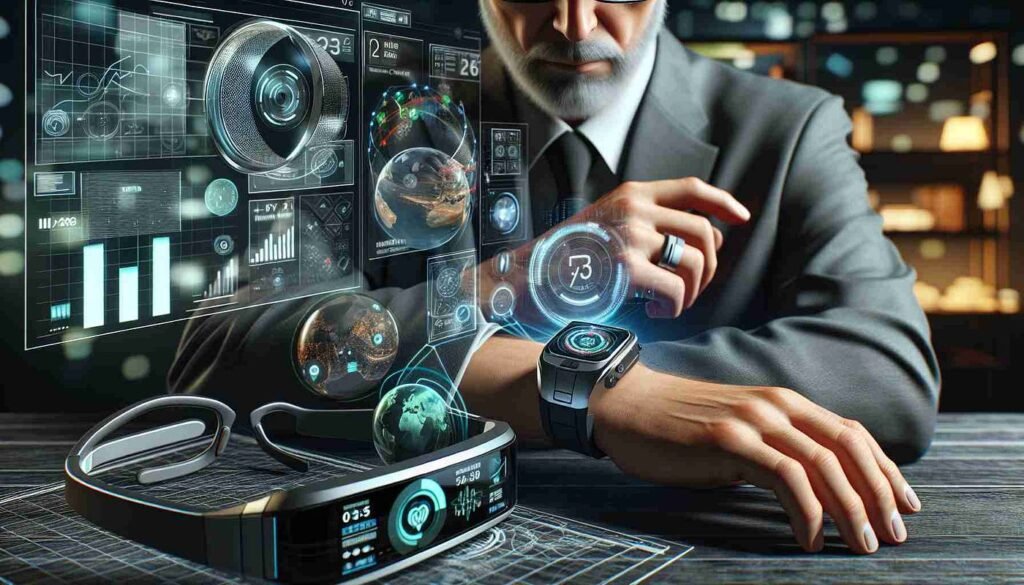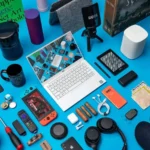Introduction: Wearables Enter a New Era
The future of wearable devices beyond smartwatches is rapidly unfolding in ways that challenge how we view technology’s role in everyday life. What began as step counters and wrist-based fitness trackers has grown into an interconnected ecosystem of devices embedded in clothing, accessories, and even medical patches. Consumers increasingly demand seamless integration, personalization, and functionality from wearables, while businesses see these devices as tools to improve efficiency, safety, and communication. The next decade will mark a pivotal shift where wearables become less like gadgets and more like extensions of our bodies—silent companions that monitor health, augment vision, and enhance productivity without disrupting daily routines.
Evolution of Wearable Devices Over Time
The wearable journey began decades ago with basic pedometers, later followed by fitness bands and watches that could measure heart rate and track steps. However, technological miniaturization, powerful processors, and advanced sensors have transformed wearables into devices capable of monitoring complex health indicators, providing real-time communication, and even overlaying digital images onto the physical world.
Key milestones in wearable evolution include:
- Early fitness trackers focusing on movement and calorie tracking.
- The smartwatch revolution, combining communication, health, and productivity in one wrist device.
- Expansion into smart clothing, rings, glasses, and implants, creating new categories of wearables.
This journey highlights how wearables are moving toward invisibility—blending into daily life while delivering powerful insights and functionality.
The Driving Forces Behind Next-Generation Wearables
Several trends explain why wearable devices are evolving beyond smartwatches. These forces are not isolated but interconnected, pushing manufacturers and innovators toward greater sophistication in design, function, and purpose.
The main drivers shaping the wearable future:
- Healthcare demand for preventive and predictive monitoring.
- AI integration that converts raw data into personalized insights.
- IoT connectivity ensuring wearables link with homes, cars, and workplaces.
- Workplace innovation for safety and productivity.
- Entertainment expansion through AR/VR experiences.
Together, these forces ensure that wearables are not passing fads but central to the future of technology adoption.
Smart Clothing: The Wearable Revolution on Fabric
Among the most exciting developments in wearable technology is smart clothing, which integrates sensors directly into fabrics. Instead of wearing a device on your wrist, users wear ordinary-looking clothes that continuously track body signals. This makes wearables more comfortable, natural, and discreet, opening applications in health, sports, and military.
Benefits of smart clothing include:
- Continuous monitoring of heart rate, posture, temperature, and hydration.
- Non-intrusive data collection without bulky gadgets.
- Adaptive fabrics that respond to stress, fatigue, or environmental conditions.
Smart clothing represents a shift where technology becomes a second skin, reshaping how humans manage health and performance without carrying external gadgets.
AR and VR Glasses: Expanding Human Vision
While smart clothing enhances the body, augmented reality (AR) and virtual reality (VR) glasses are set to redefine vision. AR glasses project digital overlays—directions, messages, translations—into the user’s field of vision, while VR devices immerse users in entirely new environments.
Real-world applications of AR/VR wearables:
- Navigation with real-time directions overlaid on streets.
- Workplace training through VR simulations in aviation, healthcare, and manufacturing.
- Entertainment via immersive gaming and live event experiences.
By merging the physical and digital, AR and VR wearables offer unprecedented opportunities for education, productivity, and entertainment.
Healthcare Transformation Through Wearables
Healthcare is arguably the most transformative arena for future wearables. Current smartwatches track heart rate and oxygen, but new devices will monitor blood glucose, hydration, and even early signs of neurological conditions. Wearables will move beyond observation into predictive diagnostics—spotting risks before they become medical emergencies.
Doctors will also rely on wearables for remote patient monitoring, reducing hospital visits and enabling continuous care for chronic illness patients. This saves costs for healthcare systems while providing personalized, proactive treatment for individuals.
Current vs Future Healthcare Wearables
| Feature | Current Wearables (Smartwatches) | Future Wearables (Beyond Smartwatches) |
| Health Data Tracked | Heart rate, steps, sleep | Blood glucose, hydration, stress levels |
| Role in Care | Self-monitoring | Predictive diagnostics, remote care |
| Design | Wrist-worn devices | Clothing, patches, implants |
| AI Integration | Basic trend analysis | Advanced predictive insights |
| Healthcare Value | Lifestyle management | Medical-grade monitoring |
Workplace Wearables: Productivity and Safety Redefined
Wearables are also reshaping how industries operate. From construction helmets with hazard detection sensors to AR glasses guiding assembly-line workers, wearable devices enhance both safety and productivity. Employers view them as tools for reducing accidents, cutting training costs, and improving communication in hands-free environments.
Examples of workplace wearable use:
- Construction: Smart helmets detect unsafe conditions.
- Manufacturing: AR glasses provide assembly instructions.
- Logistics: Wearables track worker fatigue to prevent errors.
In these environments, wearables are not luxury accessories but critical tools for efficiency and safety.
Consumer vs Workplace Wearable Applications
| Application Area | Consumer Use Case | Workplace Use Case |
| Fitness & Health | Step counting, sleep monitoring | Fatigue detection for shift workers |
| Entertainment | AR gaming, VR streaming | VR training simulations |
| Communication | Calls, messages on-the-go | Hands-free field communication |
| Safety | Fall detection for elderly | Hazard alerts in construction |
| Productivity | Calendar reminders | AR assembly instructions |
The Role of AI in Next-Gen Wearables
Data without analysis has little value, which is why AI and machine learning are crucial for the future of wearable devices. Instead of passively recording, AI-driven wearables will learn patterns, anticipate risks, and recommend actions tailored to individual needs.
For example, AI can detect subtle changes in heart rhythm signaling early cardiac issues, or predict workplace fatigue before accidents occur. This shift from reactive to proactive technology will be the defining hallmark of next-generation wearables.
Privacy and Data Security: A Rising Challenge
The adoption of wearables also raises urgent questions about privacy, cybersecurity, and data ownership. Since these devices collect sensitive health and location information, they become attractive targets for hackers. Unless manufacturers strengthen encryption and build transparent data-use policies, consumers may resist widespread adoption despite the benefits.
Core privacy concerns with wearables:
- Unauthorized data access by third parties.
- Unclear ownership of personal health information.
- Surveillance risks from continuous monitoring.
Solving these challenges will be just as important as advancing the technology itself.
Fashion Meets Function: Making Devices Desirable
For wearable adoption to succeed, devices must be both functional and fashionable. No consumer wants bulky, unattractive devices, no matter how advanced. This is why companies now collaborate with fashion houses to create wearables that blend seamlessly into jewelry, glasses, and clothing.
Smart rings, pendants, and even earrings are gaining traction, allowing users to monitor health and receive alerts discreetly. As fashion merges with technology, wearables will shift from “gadgets” to everyday lifestyle accessories.
Overcoming Technical Limitations for Wider Adoption
Despite progress, wearables face hurdles in battery life, sensor accuracy, and affordability. Smartwatches already struggle with daily charging, and advanced wearables with continuous monitoring require even greater energy efficiency. Additionally, false readings or inconsistent performance can erode trust.
Manufacturers must focus on:
- Improved battery solutions such as solar fabrics and kinetic charging.
- Medical-grade sensor accuracy to compete with clinical devices.
- Affordable pricing models to expand accessibility globally.
Addressing these pain points is vital for long-term adoption.
Entertainment and Lifestyle Expansion Through Wearables
Entertainment remains a core growth area, with AR glasses and VR headsets leading innovation. Wearables can make concerts interactive, transform gaming into immersive adventures, and bring virtual travel into homes. Lifestyle-oriented wearables like smart rings also enhance convenience by enabling contactless payments, unlocking doors, and digital ID management.
This convergence of lifestyle and entertainment ensures wearables are not just tools for work and health but platforms for enjoyment and convenience.
The Road Ahead for Wearable Innovation
The coming years will witness rapid growth in wearables, but success depends on balancing innovation with trust, accessibility, and design. Companies that deliver accurate, stylish, secure, and affordable devices will dominate the market. Governments and regulators must also create frameworks ensuring ethical data usage to encourage adoption.
Ultimately, wearable devices beyond smartwatches will reshape how humans live, work, and interact—turning technology from an external tool into an invisible, integrated partner in daily life.
Conclusion: Beyond Smartwatches into a Wearable World
The future of wearable devices is not a single product but a vast ecosystem stretching beyond smartwatches into clothing, accessories, glasses, and workplace tools. These devices will change healthcare by predicting illnesses, improve workplaces by enhancing safety, and expand lifestyles with immersive entertainment and fashion-driven designs. Yet, challenges in privacy, accuracy, and adoption remain.
If innovation continues alongside ethical responsibility, wearables will move from novelty to necessity, making the digital world wearable on our very bodies. The smartwatch started the revolution, but the journey is far from over—it is evolving into a future worn seamlessly, everywhere.
FAQs on Wearable Devices Beyond Smartwatches
1. What are the most promising wearable devices beyond smartwatches?
Smart clothing, AR/VR glasses, smart rings, and health-monitoring patches.
2. How will wearables impact healthcare in the next decade?
They will enable continuous monitoring, predictive diagnostics, and remote care.
3. Can wearables improve workplace safety?
Yes, smart helmets and AR glasses help detect hazards and provide real-time guidance.
4. What are the main privacy risks of wearables?
Unauthorized access, unclear data ownership, and potential surveillance misuse.
5. How does AI enhance wearable technology?
AI interprets data, predicts risks, and provides personalized recommendations.


